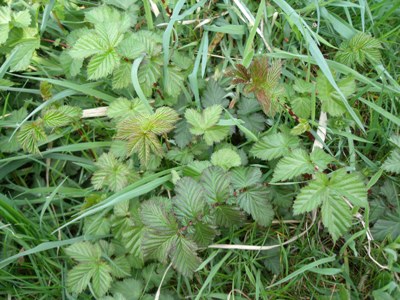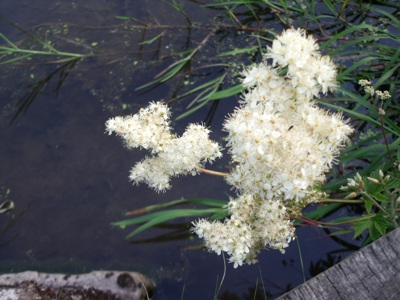
Latin: Filipendula ulmaria (previously known as Spiraea ulmaria)
Also Known As: Queen of the Meadow, Bridewort, Little Queen, Gravel Root, Trumpet Weed, Lady of the Meadow, Steeplebush, Bride of the Meadow, Meadsweet, Mead Wort, Pride of the Meadow, Meadow Maid, Honeysweet, Dollor, Meadow Wort, Bridgewort, Dollof, Lace-Makers-Herb
Family: Rosaceae
Habitat and Description: Meadowsweet likes to grow with its feet wet, and can often be found on wetland, by rivers, commons and boggy ground. It also grows in or near ditches alongside fields and is a familiar sight in the countryside, where it is clearly visible in the flowering season with its tall plumes of creamy flowers. We've got loads of it growing near us, usually on roadsides and alongside fields, unsurprisingly. The leaves are roughly diamond shaped, deeply grooved and toothed around the edges, with a fairly rigid set to the leaves. The central stem is often reddish in colour, and the whole plant, which tends to be low growing until flowering, can grow up to about 2 to 4 feet tall. The flowers are creamy coloured and have a slightly feathery appearance. They are strongly fragrant and have been used in brewing and cooking since time immemorial.
Parts Used: The herb
Constituents: Meadowsweet contains a variety of known constituents, including volatile oils (including up to 75% salicylaldehyde); phenolic glycosides including spiraein and gaultherin; flavonoids; tannins (predominantly hydrolysable); traces of coumarin and ascorbic acid.
Planetary Influence: Jupiter (although typically enough, our old friend Culeper disagrees and states that it is ruled by Venus. Since these two planets are fairly similar in terms of both being fairly mild and expansive, I don't think it really makes much difference.)
Associated Deities and Heroes: Blodeuwedd, Aine, Gwena, Venus. Other women who could be considered to be Flowerbrides, such as Guinevere. Considering the long association of Meadowsweet with Faerie, its possible other faery deities could be listed here such as Morgana, Mab and Titania, and of course other Goddesses associated with love and beauty – such as Freyja and Aphrodite.
Festival: Midsummer
Constitution: Cool and dry
Actions and Indications: Culpeper is of the opinion that the herb is used to dry the body out, and that it can stop bleeding, diarrhoea, vomiting and excessive menstruation. He also reckons that it can be used to 'make a merry heart', and comments that the leaf or flower can be added to claret wine for this purpose. If this mix is drunk warm with some honey added, it can relieve constipation, but drunk cold, it stops diarrhoea. Externally he states that it can be used to treat sores, cankers and fistulas, and the distilled water can be used to treat heat and inflammatory conditions in the eyes (one can assume he possibly means conjunctivitis.)
By contrast, Gerard does not have a great deal to say about the herb, although he does clarify Culpeper's comment regarding the eyes, mentioning that the flower water relieves burning and itching and clears the sight. He mentions that Meadowsweet is an excellent strewing herb, and that the scent of the flower gladdens the heart.
Modern authors list a plethora of uses for this plant, in particular for the ease and relief of gastro-intestinal problems such as gastric and peptic ulcers, acid reflux, dyspepsia, diarrhoea, liver disorders and related digestive upsets. The herb is an aromatic stomachic and tonic, although very astringent. It is well recommended for digestive upsets related to overproduction of mucous – the same can be said of urinary disorders. As the herb is a painkiller and anti inflammatory, it can be used to relieve the pain of arthritic conditions, sciatica, gout, tendonitis, influenza and joint aches.
It can also be used to treat prostatic enlargement and some urinary disorders such as cystitis and reddish deposits in the urine, in particular where this is accompanied by an oily film on the urine, as well as to treat urinary stones. Meadowsweet is a strong diuretic and urinary antiseptic.
The plant's immunostimulant action works through the herb's liver tonic and digestive stimulant actions. The flowers can be used fresh or dried as a diaphoretic, as well as sometimes being helpful with the management of weight gain when this is due to problems with fat metabolism and storage. I'd probably combine it with Dandelion root in this sort of circumstance.

Spiritual and Energetic Uses: There are quite a wide range of emotional and spiritual uses for Meadowsweet, including for those who have become rigid and inflexible, due to fear or anger, and who need to learn how to relax as a result. Meadowsweet is a gentle opening remedy, expanding the psyche and removing barriers and armor gently and subtly, as well as having a strengthening and soothing action. It is especially suited to young women who feel overly self conscious and shy regarding their sexuality, or are frightened by it, especially where this is as a result of sexual trauma. It reassures and comforts, as well as encouraging self confidence and the ability for a woman to put her shoulders back and meet the world head on. It is particularly well suited to those who are tense, and whose tension manifests as tightness and tension in the head and neck.
The reason why Meadowsweet is so good for these purposes is pretty self explanatory if you take a closer look at the legend surrounding Blodeuwedd. Meadowsweet is associated with the Flowerbride aspect of celtic folklore, as can be seen in the plant's association with Blodeuwedd, the original Flowerbride, the woman who was created to be the 'perfect maiden', to be pliable and submissive and have no ideas of her own, and perhaps just as importantly, to never really move beyond the phase of 'maiden'. When looked at in these terms, it would make sense that the flower used to create the original Flowerbride, who broke out of the mould her creators cast her in and chose to live her own life, her own way, would be useful for people who have been forced into being or behaving in a way that is not 'them', on a fundamental level. It does this in a gentle way because Meadowsweet is a gentle flower, rather than the more aggressive Dandelion, which acts on the liver and therefore can have a more dynamic, rapid action on the emotions.
Magical Uses: Meadowsweet is used for love, peace and happiness – all interesting uses in light of the herb's past uses as a strewing herb! The fresh plant is used as an altar decoration for love magic, and the dried herb can be used in various love potions. The scent of meadowsweet cheers the heart. The plant can be used in magic to discover thieves. The flowers can be used in bridal bouquets. The whole plant is one of the druids' most sacred herbs.
Meadowsweet is used for anyone working with the Goddess in her Maiden aspect - the flower added to bridal bouquets brings joy and blessings to the bride. The scent of the flower can be infused into an oil which, if the scent of which is inhaled nightly, will make a woman more attractive and help her cross paths with her soulmate. This magic is best performed on Beltaine Eve – typical really given that Meadowsweet does not flower until considerably later on the year!
The flower is sometimes associated with the festival of Lammastide, which is dedicated to the Earth Goddess in her Harvest Mother aspect. Meadowsweet tea can be drunk to heighten the energy and merriment of the occasion, and the flower's heady perfume has a narcotic effect that can help a person contact the heart of the Great Mother.
Folklore: Meadowsweet is one of the three herbs held to be sacred by the Druids, the other two being Vervain and Water Mint. In more recent history, the plant used to be known as 'Spiraea ulmaria', and is the plant from which the original aspirin was derived, as it has high levels of salicylic acid, an anodyne.
The plant was historically used to flavour mead, hence the folk name of mead wort. It was a popular strewing flower, and was often used in bridal bouquets and posies.
While researching the plant, I encountered some new lore associated with it that I had not come across before, which comments that it was given to Cuchulainn to calm his fits of rage and outbreaks of fever, as is apparently shown in the plant's Gaelic name, 'belt of Cuchulainn'. This is interesting as the plant is cool and dry, and would would certainly be useful in the treatment of more choleric problems such as anger!
A few more tidbits of folklore associated with the plant concern the plant's strong association with death. The scent of the flowers could induce a deep and fatal sleep under some circumstances. Legend says that Meadowsweet was given its fragrance by the Moon Goddess Aine. The flowers used to be dried and smoked in Nottinghamshire, where they gained the name 'Old Man's Pepper', after the Devil. Interesting given that it was probably less damaging to the health than tobacco is!
Dose: The maximum recommended dose is up to 4mls three times per day, of 1:5 45% tincture, or one cup of water poured over up to 2tsps of dried herb, infused for up to 15 minutes and drunk three times a day or as needed.
Contraindications: Those allergic to aspirin shouldn't risk taking this herb.